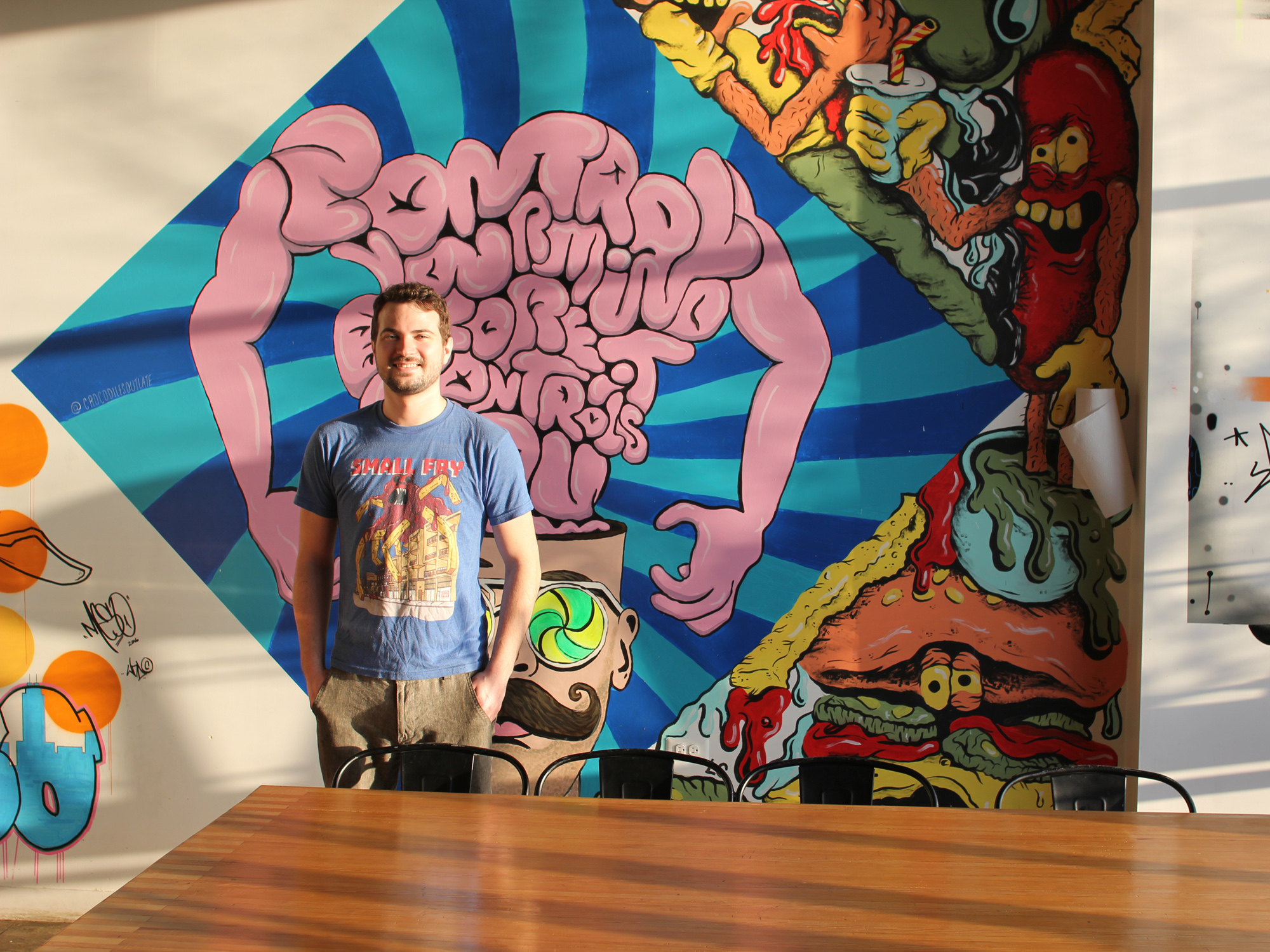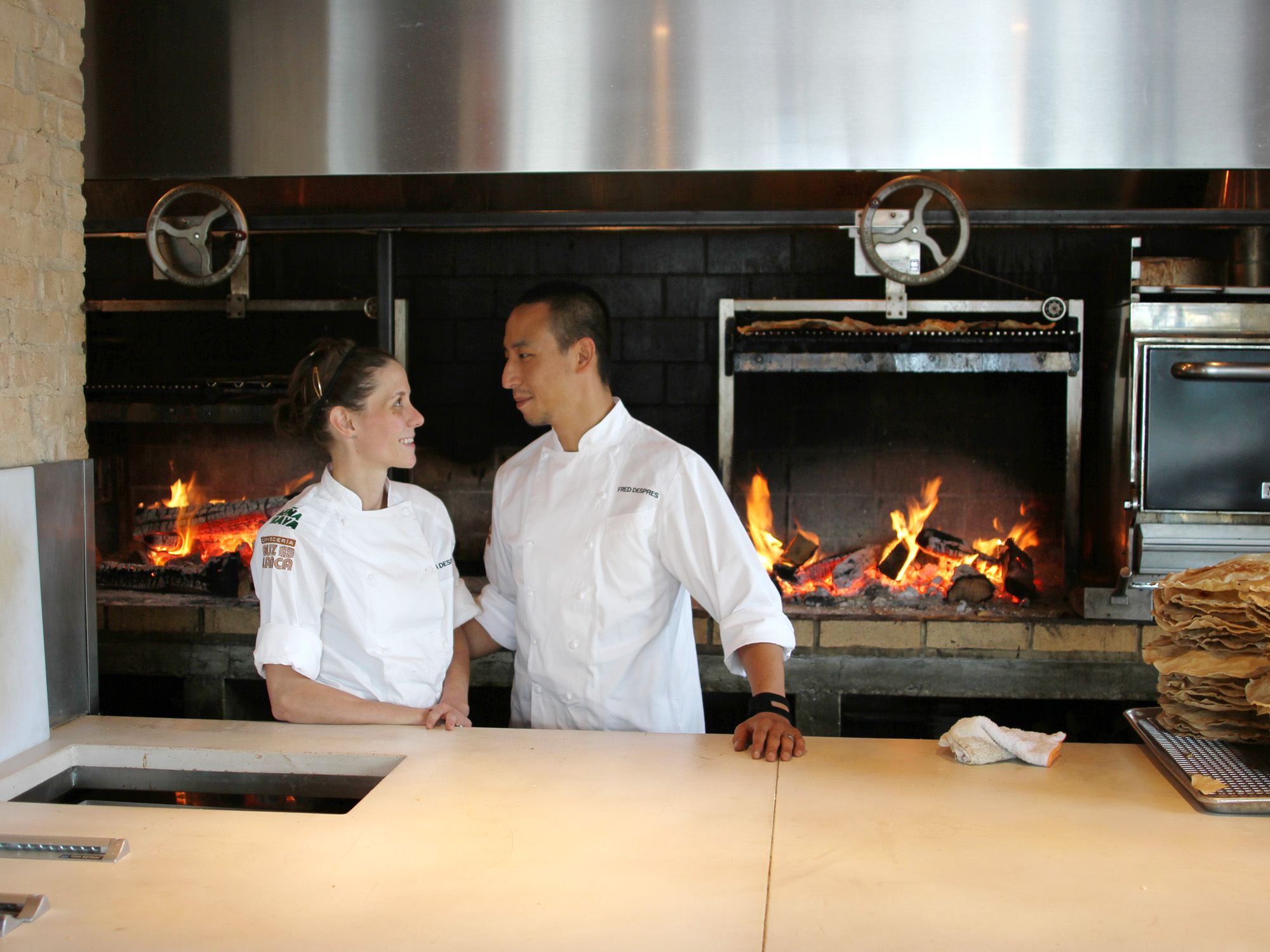“EVERY RESTAURANT SHOULD HAVE A FLAMETHROWER,” John Manion says as he unleashes a spray of blue flame on the logs in his Argentine grill, an act with all the primal satisfaction of Sigourney Weaver roasting a xenomorph. As the restaurant world grows increasingly minimalist and precise, all tweezers and sous-viding at 160 degrees, Manion’s El Che Bar, with its display of flaming grills against the back wall, seems a hypermasculine throwback, with the Nick Offerman-esque Manion master of his tools and his flame as he hurls smoking logs into the iron-barred cage and then beats on them with a spiked poker.
“It’s definitely a selling point to cooks, that they get to come here and play with fire,” Manion explains as he breaks apart the coals, sending sparks flying. After our interview, he’s making a run to the hardware store. “I spend more time at Home Depot than Restaurant Depot these days.”
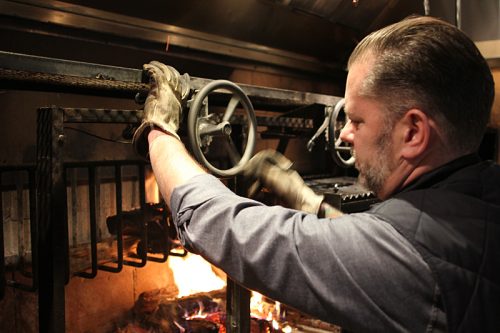
John Manion
Wood fire grills exist in plenty of kitchens, but the visible hearth fire in a kitchen open to guests kicked off in upscale dining with The Promontory and really became a thing last year, forecast by Sarah Freeman in Eater and mocked by Joe Campagna at Fooditor. El Che Bar, Leña Brava, and Roister all made it a centerpiece of the guest and dining experience within a few blocks and a few months of each other last summer and fall.
I thought it would be interesting to talk to one of them now that they’ve had several months of working with a kitchen built around fire, and few if any other means of preparing food. How does it work? What can you do, and not do? Manion and I sat down to talk about it, by the light of a blazing kitchen.
FOODITOR: You lived in South America as a child, your father was an American doing business there, and you’ve returned many times, so you had a particular familiarity with Argentine grills. What has been your experience so far running a restaurant based on that concept?
MANION: My point of view, from where I stand six months in, is that I wanted to do this for a long time, and I’ve been researching it a long time, so it wasn’t like Jesus Christ it’s 2016, we need to have a wood-burning grill. People have been doing it a long time, it just got really popular, last year was the year of, let’s burn shit.
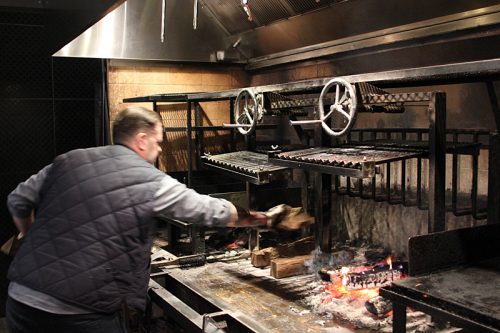
When you open a restaurant, you have this strong sense of who you are. But then that’s not who you are at all, it reveals itself. Your customers dictate it a little bit, but also you start cooking and playing with things and the path becomes clearer. We have four stations here, and that’s changed over the course of time. You figure out what works, you figure out what flows, what you can and cannot do.
In terms of having only fire on the line, it’s been great because it’s limiting. We’re just doing this, I only want to do this. I don’t want fucking circulators, I don’t want an induction burner on the line because we can’t do it any other way. Let’s figure out what we can do and just do that.
I really like the direction where it’s become lighter and bolder flavor-wise. Cleaner, simpler. It’s revealed itself. We have changed the configuration a little bit, and as we go on we’ll continue to. I’ve been working with a guy who is kind of custom-building things as we go along, and it’s been a really fun collaboration. There’s nothing that we can conceive that he can’t do. So my advice would be, find a good metal guy if you’re going to try this kind of thing.
But I’m more in love with this method now than I was as an idea.
Tell me about your experiences with cooking this way in South America.
The food in Argentina is fantastic. I don’t know that it’s one of the world’s great cuisines, it’s simple, it’s straightforward. When you’re in Buenos Aires there’s that immigrant layer that adds nuance and pushes cooks to do different things. But mostly it’s very straightforward, pseudo-Italian and those flavors, and we’ve strayed from that a lot, but it holds true to what I’ve always thought our mission was, to be inspired by South American outdoor cooking, but not a strict adherent to it.

The thing about living in South America is, one, you spend a lot of time in peoples’ backyards, just that tradition of churrasco, not meat on swords but cooking over charcoal. Brazil has a great tradition of it, the smell just permeates the air, like in Buenos Aires. And then, going to the churrascarias, you’d go out with the other expats and sit around and eat meat and rice and beans. And that kind of left an impression that when you move back to the states, all of a sudden that’s missing from your life. I didn’t know how good I had it until I was gone. The Kenmore gas range out back with burgers and hot dogs—it’s not really the same thing.
So I think that cooking outdoors as a way of life mentality kind of stuck with me. And then in my late 20s I started going to Argentina in earnest. I fell in love with that country, it kind of became my other place, and the first time I went there it was like, everyone killed a cow for my arrival. And I will tell you, eating red meat and drinking red wine, two meals a day, for two weeks… I was not built for that.
And then I’d go back for a month a year for a while, and I’d see this kind of rig in the restaurants, it was not a strange sight. It’s kind of religion and sport and a pastime all rolled into one. Everyone kind of has a grill like this on their apartment deck or in their backyard, and Sunday is really for, all day you’re going to eat meat over charcoal and drink some red wine, there might be some Fernet Branca mixed with Coca-Cola, there’s probably going to be a soccer game on that you may or may not care about, there’s going to be a lazy nap at some juncture… so it was really that experience that I started having 15 years ago or so, that developed into this idea that I wanted to be cooking outside, inside.
You said you’ve reconfigured things on the grill since opening. Tell me what changed, and why.
What we did was, we centralized the two grills. Where we had two on the right that we considered the grill station, and then one on the left, which we did fish and veg on that. What we found was, we were using the far-right grill to sort of hold things, be it sizzle platters or to temper meat up on a sheet tray. We have this rudimentary oven box here, and we put that all the way to the right so we can hold things, we can smoke things during the day.
You don’t just want char on everything. There needs to be a brightness to what you’re doing, too.
The right hand grill is still meat—we found that with the speed that we’re doing things, we didn’t need two [meat] grills, because it’s a very high intense heat and everything’s on and off very quickly. So we have the one quote-unquote oven, we have one flat top or chapa, and then the grill on the right hand side would be meat and the grill on the left hand side would be veg and fish. And then one chapa that’s fish, and one that’s veg.
Most of the vegetable cooking that we do is on the chapa, so the left grill is really fish—it’s salmon and shrimp. We have to be really careful in this day and age about cross-contamination, we try to keep everything real clean, and real segregated that way. Shellfish allergies are no joke.
It’s interesting that you say it’s so fast, because I know at Leña Brava, they found they couldn’t keep up with the volume of the whole fish the way it was originally set up, so they had to make it more intense to cook more quickly.
I feel that’s the method here. We were there from the beginning. I feel like we’ve learned how to burn a little bit better and more efficiently. I think they’re probably coming at it from a regional Mexican standpoint, where you can cook longer. The Argentine grills that we put in—I already knew how to use. I knew that it was high, intense heat. We’ve raised the fire a little bit, truth be told I’m probably going to put it down three or four inches. But we’re cooking over coals, and you have to engineer the menu for that. I don’t do a whole fish off these grills because the outside would be burnt, the inside wouldn’t be. That’s a woodburning oven situation.
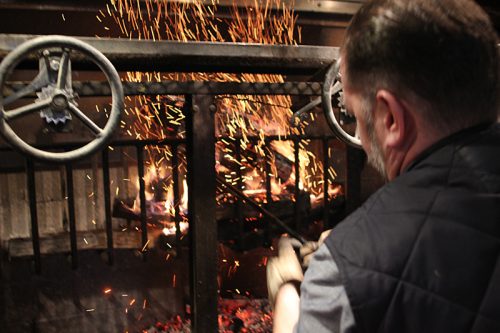
But that’s indicative of what I’m talking about, because—here are the things that we can do. Let’s do them great, and let’s figure out how they fit into our mindset as cooks of how we’re going to serve things. It keeps us very singular in thought. This cuisine should be good enough to keep peoples’ attention, and to keep our attention. The method becomes the cuisine—burning things.
What holds true about cooking outdoors holds true here. You don’t just want char on everything. There needs to be a brightness to what you’re doing, too. It needs acid, it needs a counterpoint. We had the impulse to add char to everything early on, and we became familiar with redundancies in flavor. We have this toy, let’s do everything! A little restraint goes a long way. Those are our marching orders in terms of how we’re going to cook here.
Is there anything you’ve tried cooking that it was just like, we can’t do that here?
It’s not so much cooking specific things, as it’s approaching the menu as if we had all the other stuff, you know what I mean? We did a baked potato fugazzeta-style, which is an Argentine pizza. And it was something that Mark [Steuer] came up with which was brilliant in its inception, kind of an eleventh-hour thing, and what we found was that holding it was a problem. We had a lot of burnt or tepid ones, and that was a lesson that there can be great dishes that you can’t execute.
We do great with quail, I sell a ton of quail. I’ve resisted many requests by investors and also from customers to introduce chicken. For two reasons. One, I don’t want to sous vide it, and two, I don’t want to introduce raw chicken to this environment. So that’s something I think that we might play with roasting during the day, and as we move forward, it’s a problem to solve, but I haven’t gotten there yet—I haven’t done it successfully, to get it to what it needs to be.
But really, knowing how the pieces fit together, everything’s pretty great off of this. As long as it’s this thick [holds fingers a half inch apart]. But even, we’ve learned how to do bigger steaks. The first two weeks, we did a tremendous steak that we did sous vide. And two weeks in, I said, cool, training wheels are off, we’re done with this. And that was met with blank stares, how we gonna do that? Well, you figure it out. Because people have been doing it for millennia.
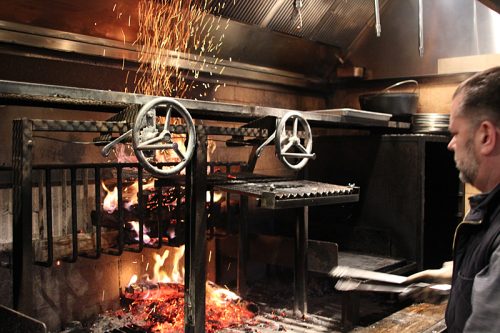
Working on these grills is sometimes more akin to being a sauté cook than a grill cook. Because I’ve found, in my travels, sauté cooks are always clever about using the oven, using the rack above their sauté station. You kind of know where all the heat is, and so if you understand the thermodynamics of your station… maybe that steak goes on top for a couple of minutes. You know that it’s probably 350, 400 degrees up there. It’s a fairly intuitive way of cooking that just strictly grilling isn’t.
It’s amazing to me, and I think it’s a testament to the cooks that are working here, that they’ve adapted very quickly, they’ve become very clever at using this beast. I’m very happy that we’ve resisted the urge to add anything else to this, sort of, microclimate. We gave ourselves no safety net. And if you give yourself another method, you end up gravitating towards it. Because it’s easier—it’s safer.
I’m really proud of these guys that they’re pulling this off at a very high level every day, and I think it’s a bunch of guys who now have a skill set that they couldn’t have picked up anywhere else, but has made everybody a better cook.
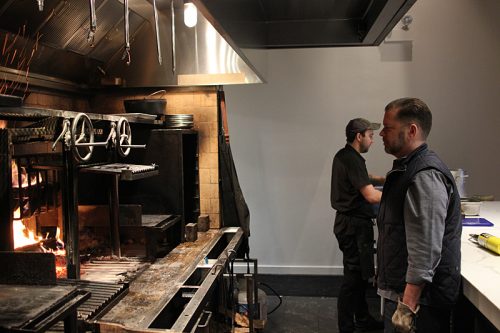
Michael Gebert stokes the fires as editor of Fooditor.
El Che Bar and 98 other places can be found in the guide for real Chicagoans. Get The Fooditor 99 at Amazon and for Kindle here.
Latest
Join the Discussion
After you comment, click Post. If you're not already logged in you will be asked to log in or register with Disqus.






